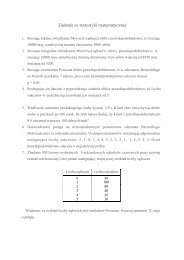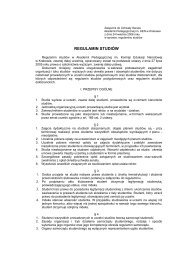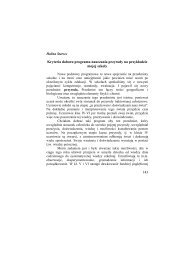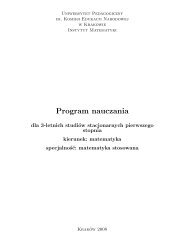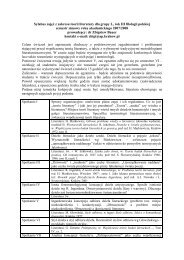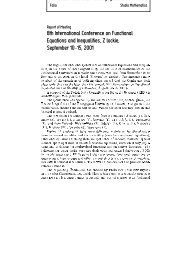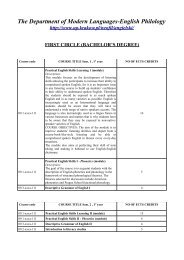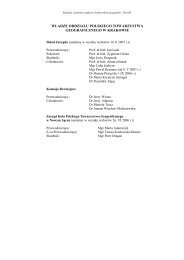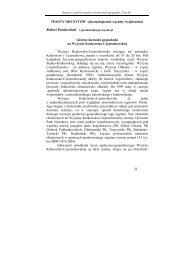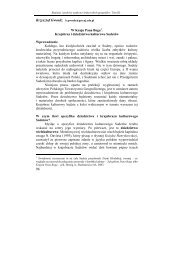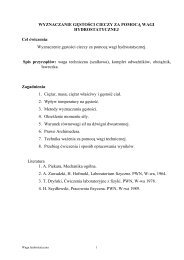Effect of Pd impurity on charge and spin density in metallic iron ...
Effect of Pd impurity on charge and spin density in metallic iron ...
Effect of Pd impurity on charge and spin density in metallic iron ...
Create successful ePaper yourself
Turn your PDF publications into a flip-book with our unique Google optimized e-Paper software.
B > <strong>and</strong> shifts relative to <strong>metallic</strong> ir<strong>on</strong> at room temperature < S > are shown <strong>in</strong> Table IV.<br />
C<strong>on</strong>tributi<strong>on</strong>s lesser than or approximately equal 1 % are not shown. A distributi<strong>on</strong> obta<strong>in</strong>ed<br />
for pure ir<strong>on</strong> represents a resoluti<strong>on</strong> <str<strong>on</strong>g>of</str<strong>on</strong>g> the method. It<br />
is <strong>in</strong>terest<strong>in</strong>g to note that the average fields obta<strong>in</strong>ed<br />
this way are practically the same as result<strong>in</strong>g from the<br />
b<strong>in</strong>omial distributi<strong>on</strong>. On the other h<strong>and</strong>, shapes <str<strong>on</strong>g>of</str<strong>on</strong>g> the<br />
Hesse-Rübartsch distributi<strong>on</strong>s are vastly different<br />
from the shapes <str<strong>on</strong>g>of</str<strong>on</strong>g> the corresp<strong>on</strong>d<strong>in</strong>g b<strong>in</strong>omial<br />
distributi<strong>on</strong>s. Hence higher than the first moment are<br />
not reproduced reliably by the Hesse-Rübartsch<br />
method for these relatively narrow distributi<strong>on</strong>s<br />
despite quite good reproducti<strong>on</strong> <str<strong>on</strong>g>of</str<strong>on</strong>g> the spectra shape.<br />
On the other h<strong>and</strong>, average shifts obta<strong>in</strong>ed by all three<br />
methods applied are practically the same for all<br />
samples. Figure 4 shows distributi<strong>on</strong>s obta<strong>in</strong>ed with<br />
the smooth<strong>in</strong>g parameter [12,13] set to unity, i.e.,<br />
close to the optimum. However comparable quality<br />
fits can be obta<strong>in</strong>ed with very large values <str<strong>on</strong>g>of</str<strong>on</strong>g> the<br />
smooth<strong>in</strong>g parameter. Distributi<strong>on</strong>s obta<strong>in</strong>ed <strong>in</strong> the<br />
latter case have dist<strong>in</strong>ctly different shapes than those<br />
<str<strong>on</strong>g>of</str<strong>on</strong>g> Figure 4, particularly for larger palladium<br />
c<strong>on</strong>centrati<strong>on</strong>s.<br />
Figure 4.<br />
Distributi<strong>on</strong>s <str<strong>on</strong>g>of</str<strong>on</strong>g> the hyperf<strong>in</strong>e field obta<strong>in</strong>ed by the Hesse-Rübartsch method.<br />
Table IV<br />
Average hyperf<strong>in</strong>e field <strong>and</strong> relative spectral shift obta<strong>in</strong>ed apply<strong>in</strong>g Hesse-Rübartsch<br />
method.<br />
c<br />
[at. %]<br />
< B ><br />
[T]<br />
± 0.02<br />
< S ><br />
[mm/s]<br />
± 0.002<br />
0 32.99 0<br />
0.95 33.18 0.009<br />
2.76 33.56 0.023<br />
4.71 33.88 0.035<br />
6.63 34.25 0.045<br />
8.04 34.52 0.056<br />
10.59 34.64 0.065<br />
8



